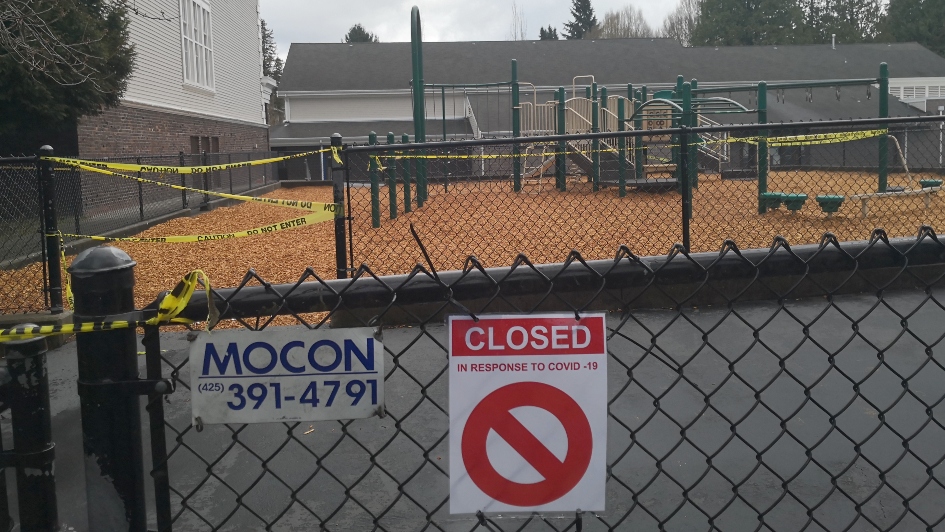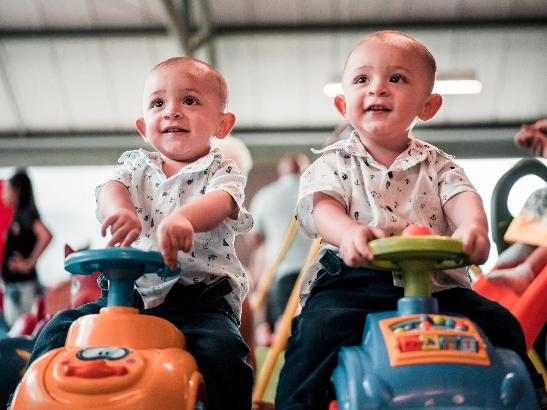
Image: Elementary school shut during the COVID-19 pandemic. Credit: Buidhe, Wikimedia Commons
The current COVID-19 pandemic is a startling example of the price that can be extracted by a newly emergent, opportunistic viral infection let loose on a host population that is highly social and mobile. It’s not the first such plague by any means, and nor will it be the last.
But while COVID-19 is wreaking havoc on the world, at the same time it provides opportunities. For example, we are seeing new strategies for fast-tracking the design, production and testing of vaccines, and potentially important novel insights into the regulation of inflammation.
The pandemic throws up other challenging questions and cIues. Why is it that Black ethnic groups have more severe COVID-19 disease? They also suffer more from seasonal influenza in the UK. Is it their higher rates of co-morbidities? Or might it be a more fixable deficiency of vitamin D, compromising the immune system?
The pandemic is in essence a giant experiment of nature. There is a history here.
‘Experiments of nature’ are events that arise naturally, by accident or serendipity, and with a dramatic effect that can reveal something hitherto cryptic. I include in this definition human social contrivances that inadvertently provide an ‘experiment’ – for example changes in human behaviour within society which have a biological impact that affects our health. The proviso is that these natural experiments, to be informative, require that is there is a shrewd observer around.
T cells, leukaemia in twins and brain plasticity
My first exposure to this notion was, as a student, listening to a lecture by the distinguished American immunologist Bob Good. He told how a vital clue about the functional heterogeneity of the immune system came to him from observing people with a very rare genetic disorder called DiGeorge Syndrome.
These patients lacked a form of cellular immunity and were very vulnerable to viral infections. They also lacked a thymus. Here was an astute observation that helped prompt our current-day understanding of the existence and role of T cells.
Fast forward some two decades and I suspect Good’s advice was still echoing in my ear when we realised that the very rare clinical circumstance of identical twins who both had leukaemia provided a unique opportunity to identify the sequence of pre-and postnatal genetic events driving that cancer.
Twinning in humans has provided a striking example of an experiment of nature. The comparison of genetically identical (monozygotic) with non-identical (dizygotic, 50% DNA shared) twins has provided fertile ground for exploring the relative contributions of genetic background (‘nature’) versus the environment (‘nurture’) in a multitude of human traits from height to auto-immune disease and adult cancers. Twin studies revealed that breast and prostate cancers had a larger inherited component than most other common tumour types.
Similarly, neurologists and psychiatrists have deduced much about the topographical organisation of the brain from rare behavioural disorders. Books by Oliver Sacks have chronicled many extraordinary and bizarre examples, but, to be frank, leave me crying out for mechanistic insights, which is a limitation of purely observational studies. But it’s a starting point.
And still within the craniosphere, did you know about how the brain of individuals born blind re-organises itself? Turns out that the vacant optic zones become invaded and colonised by auditory neurones. And the consequence is substantially heightened sound perception plus the bonus of perfect pitch. A revealing insight into the remarkable plasticity of brains in infants.

Image: Twins sitting in toy cars. Credit: Cleyder Duque, Pexels
The discovery of vaccines
Many of triumphs of the scientific method were preceded by and inspired by experiments of nature. Vaccination is one of the undoubted successes of modern medicine having eradicated smallpox worldwide, saved millions of children from dying with measles and halted the ravages of polio, and now being on track to reduce rates of cervical cancer by some 90% via human papillomavirus (HPV) vaccines. We all hope there is something similar on the near horizon for COVID-19.
Vaccination’s 18th century scientific hero was Edward Jenner. But his experimental tactic of injecting extracts of cowpox lesions as a ‘vaccination’ (vacca = cow) against smallpox was predicated on the folklore observation, or natural experiment, that cow maids incidentally contracting cowpox didn’t suffer the ravages of smallpox.
As a postscript: Lister wrote up his first experimental endeavours involving an eight-year-old healthy recipient of cowpox inoculation in 1797 for the Royal Society. His paper was rejected. That must have cheesed him off no end. He had after all been elected a Royal Society fellow some 10 years’ earlier, but for another quite different discovery – the parasitic habit of cuckoos.
"A striking validation of Darwin, in real-time"
The longest running natural experiment involving living organisms, for some 4 billion years, is evolution itself. It operates by natural selection and there are countless, wonderful examples which illustrate the extraordinary resilience and adaptability of the biosphere.
One of my favourites involves Chernobyl, the nuclear plant in the Ukraine that exploded in 1986. That building is now derelict and encased in concrete. But disasters, man-made as in this case, or natural as with mass extinction events, usually spawn opportunities, and one species spotted a free lunch at Chernobyl.
Jet black fungi adorn the walls of the old reactor. The trick they have come up with is to use melanin to transduce gamma radioactivity into chemical energy for their growth and sustenance. It’s a striking validation of Darwin, in real time.
A parallel story has now emerged with marine bacteria that have evolved to munch their way through our discharged plastic. Both stories could be very good news for waste disposal.
The never-ending saga of evolution has thrown up more than a billion solutions to survival challenges, not by design but by the simple device of random and re-iterated shuffling of DNA, coupled with selection of what works best. And of course we humans have been players in the game.
Why is the sickle cell gene, lethal in its homozygous state, so common in populations of West African descent? It took the brilliant imagination of the polymath scientist JBS Haldane to surmise, correctly as it turned out, that carriers have a survival benefit from malaria. Experiments of nature don’t always broadcast their implications; they have to be deduced by smart observers.
And lastly on the evolution trail, many problem-solving adaptations, naturally selected, have inspired human engineering solutions. How about Velcro? The design of this material is based on the ultrastructure of the foot pads of a gecko that enables it to stick upside down on ceilings, or trees.
Natural experiments and cancer
Nearer to home, in the cancer field, there are many examples of natural experiments. Several extensively used drugs are of natural plant origin including vincristine and taxol. Traditional medicine discovered many effective medicines way before white-coated boffins got in on the act. A striking example is the drug artemisinin, used for centuries in China as an antimalarial and now a frontline treatment for that parasitic disease worldwide.
Experiments of nature or natural ‘social’ experiments can provide vital clues into the causes of disease too.
It’s been recognised for centuries that nuns in convents have relatively high rates of breast cancer and vanishingly low rates of cervical cancer. This observation offers valuable clues on causation but it took a very long time for these to be picked up. We now know that nulliparity, or not having children, increases breast cancer risk and that sexually transmitted HPV causes cervical cancer.
Breast cancer that runs in families is often caused by mutations to the BRCA 1 and 2 genes. The most common mutations we see in these genes arose hundreds or maybe a few thousand years ago, as an accident, in a single individual’s germ cell. We now see familial breast cancer in the descendants of that ancient founder – and these families give us another experiment of nature.
Studying them has given us an understanding of breast cancer genes and their functions – and has led to new targeted cancer drugs called PARP inhibitors, which are used specifically in women with BRCA mutations.
Another revealing case study of the causes of cancer is in Africa. In some areas of equatorial or subtropical Africa, and in a part of Central America, there is around a 1% incidence of gene mutations resulting, in the homozygous state, in a lack of melanin and albinos.
The striking consequence is an almost 100% incidence of lethal squamous cell carcinoma before the age of 35 caused by the loss of the skin’s natural protection against the high levels of UVB exposure in that part of the world.
I used this observation to argue that lethal cancer could have provided the selective pressure for the evolution of black skin in our early ancestors in Africa almost 2 million years ago. Contentious speculation some would argue. And not an experiment that’s likely to be repeated.
How the closing of schools gave insight into the causes of ALL
Other natural experiments have had an important impact on our attempts at the ICR to unravel the cause of childhood leukaemia. In 2003 the SARS epidemic led to Hong Kong closing all its schools for a year. That social change removed major, contact-based sources of common childhood infections.
The consequence was a significant drop in infectious diseases such as measles during that year. But there was also a decline in cases of childhood acute lymphoblastic leukaemia, but not of brain tumours, something which my team’s infection-based model of the causes of ALL predicts.
I couldn’t have designed an experiment like that. But now, it’s happening again with COVID-19. We will be assessing incidence rates of ALL versus other paediatric cancers over this year to see if the Hong Kong experience is repeated. Sweden, where schools didn’t close, provides a natural control.
These natural experiments provide tantalising clues and some confirmatory evidence. But they are still, essentially, guilt by association and don’t in themselves prove anything. They won’t ever replace our contrived experiments in the lab or population-based epidemiological studies. But, personally, I’ll take all the help I can get.
What’s your favourite natural experiment?